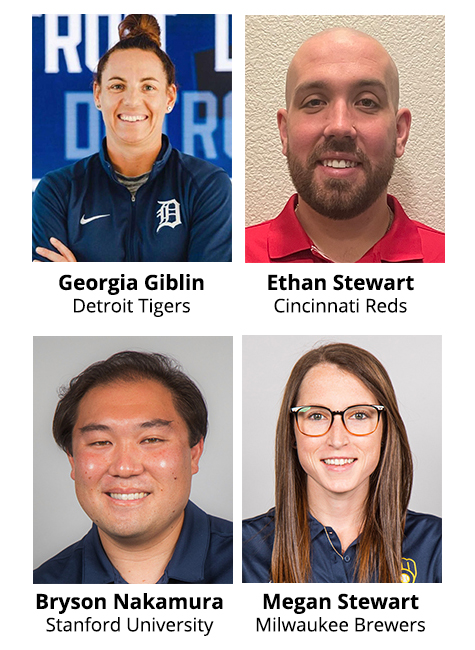2022 SABR Analytics: Watch highlights from the Biomechanics Panel
 At the SABR Virtual Analytics Conference on Saturday, March 19, 2022, we held a panel discussion on What is Biomechanics and How is it Used in Baseball?
At the SABR Virtual Analytics Conference on Saturday, March 19, 2022, we held a panel discussion on What is Biomechanics and How is it Used in Baseball?
Panelists included Georgia Giblin, Director, Performance Science with the Detroit Tigers; Bryson Nakamura, Director and Head Sport Scientist for the Stanford Baseball Science Core; Ethan Stewart, Applied Biomechanist for the Cincinnati Reds; and moderator Megan Stewart, analyst with the Milwaukee Brewers Performance Science Department.
Here are some highlights:
On biomechanics, sports science and the impact in Major League Baseball
- Ethan Stewart: “I think if we go back 10 or 15 years in baseball, it’s not this way. Sports science is new and we’re trying to get things accomplished. I think what we have seen with the growth of biomechanics and the data that’s being collected within analytics, we are seeing this push for everyone to work together with the player and the coach to get them where we think they should be.”
- Nakamura: “If we think about what biomechanics data represents its really just a mechanical output of all of motor decisions, the cognitive decisions that – whether in hitting or pitching or fielding – we are measuring from a biomechanical perspective.”
- Giblin: “We, as biomechanics and performance scientists, can add a lot of value to some of the things the other departments are doing. Biomechanics, at its core, is looking at the laws of movement and how that relates to what a player does to throw a 100mph fastball… What is the player doing to achieve that?”
- Megan Stewart: “The way I define biomechanics is that it is kind of the engineering of the body, it is split up into kinematics and kinetics. The kinematics is how are they moving – how a pitcher throws 100 mph – and the kinetics is how do they get to that motion – how are they able to throw 100 mph.”
On advancing technology and how it is used in baseball
- Ethan Stewart: “Within all of this technology, I think the biggest thing is that if you had a bird’s-eye view of all 30 organizations, there’s probably pieces of technology that all 30 of us are using, but none of the 30 are using it the exact same way because we’re all utilizing things and finding our own way to make it work for our questions. We find the technology that can help us solve it and that means that a lot of us can be using the same technology in a multitude of different ways.”
- Giblin: “The benefits of these types of apps are their portability… They bring biomechanics to the masses and really open some people’s eyes about this discipline and how the body works. From a more professional standpoint, there’s gold standards and there’s obviously a scale. If this technology is, potentially, not as accurate or not as reliable, but it affords you the opportunity to capture data somewhere where you usually can’t, then maybe it has a use.”
On how the collection of data can help both organizations and athletes set and achieve goals
- Nakamura: “More data is not necessarily better. In my opinion, better data is better. We define ‘better’ means that we need to understand the ‘why’ behind what we’re framing up and out of those, each team is going to have similar subsets of metrics that they value, but at the end of the day, those metrics should then create a behavioral change in your organization.”
- Giblin: “If we have information, it’s a lot easier for us to track the players progress and see [if] they are getting back close to where they were prior to injury…. Obviously, two people could have the same injury and they’re going to progress at different rates, but if we’re able to track how those players are progressing and how they’re returning to play relative to themselves… I think that goes a long way in helping us to make sure we do the right thing by each individual player.”
- Ethan Stewart: “We try our best to keep a lot of the stuff that we do inside of our house because we believe we are building the best player development plan possible for our athletes and we want to create the best team on the field… When we’re getting incremental increases in performance because of something that we’re doing or we’re changing, that’s stuff that we’re trying to utilize for ourselves to then create the best player development atmosphere to get our athletes up to the highest level performing at their maximum potential.”
On combating resistance from players and coaches about biomechanics
- Giblin: “Sometimes, I think that we do a very poor job of educating our coaches and our players about some of these things. Biomechanics and performance science, in general, right now is just expanding like crazy through the game of baseball and it seems as though every week, every year there’s a new technology, there’s something new to learn and we’re just constantly bombarding our coaches and our players with these things. Sometimes we fall behind on educating them about why we are doing this. There’s a little bit of resistance because they don’t understand it and I think once we do our due diligence and help them understand… that goes a long way into kind of breaking down that barrier that they may have about wanting to not use it. The second part of that for me is reassuring the coaches that I am here to help you.”
For more coverage of the SABR Analytics Conference, visit SABR.org/analytics.
Transcription assistance by Sydney Dixon.
Originally published: March 28, 2022. Last Updated: March 29, 2022.


